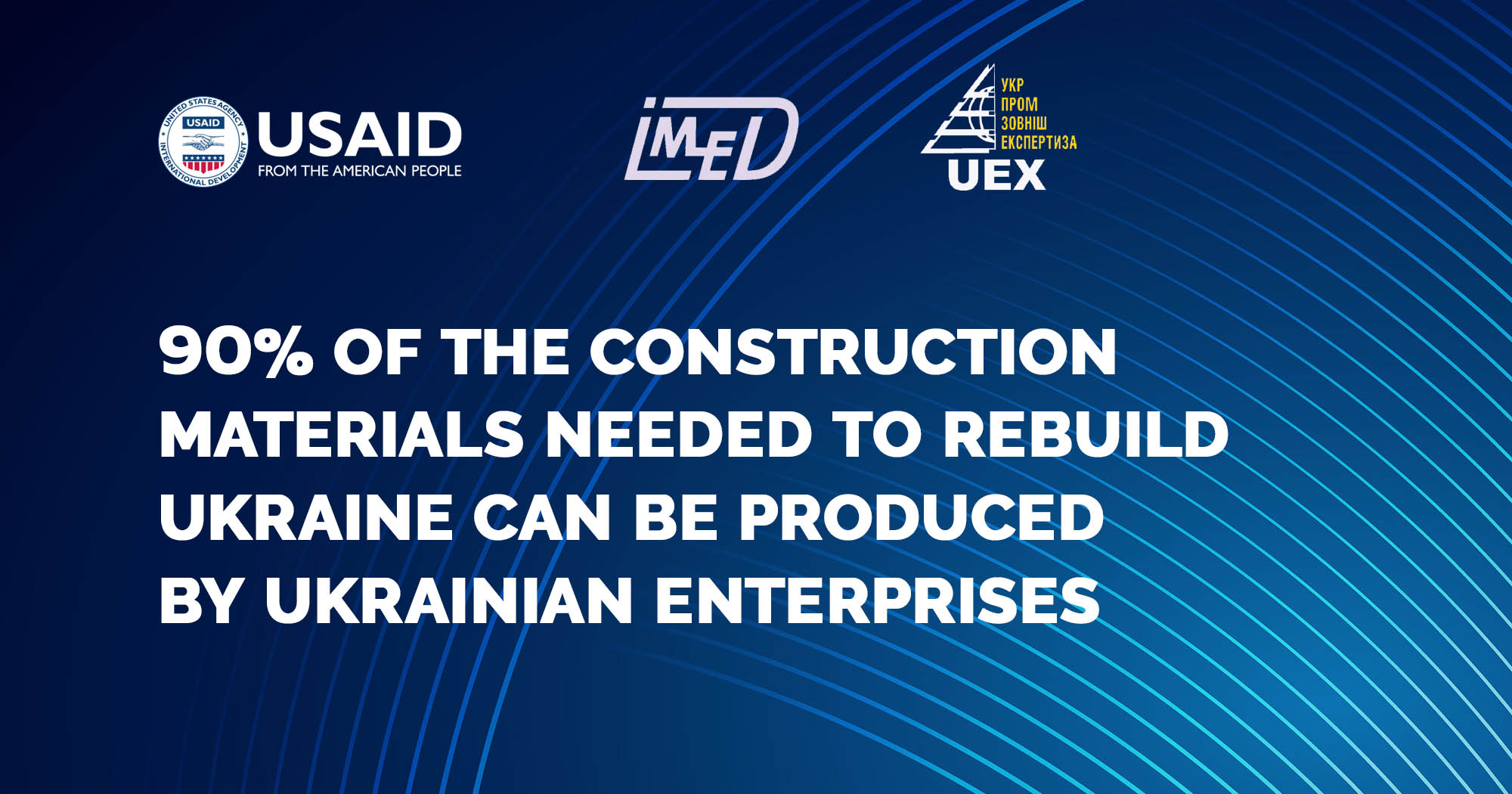Almost 90% of the construction materials needed to rebuild Ukraine can be produced by Ukrainian enterprises. This is evidenced by the results of research conducted by specialists from the NGO Institute of International Economic Research and the State Enterprise Ukrainian Industry Expertise with the support of the USAID Economic Resilience Activity (ERA).
Although the war is still ongoing, Ukrainian authorities and western partners are already in the process of considering possible solutions for reconstruction. Without such solutions, it is impossible to establish normal living conditions in Ukraine, return millions of refugees to the country, and reduce the gap in economic development and income compared to the EU countries.
“In 2022, we supported a research work by the Kyiv School of Economics (KSE) regarding the scale and cost of damage to infrastructure and residential buildings in Ukraine. In this research, KSE found that as of November 2022, the damaged facilities will need construction materials and equipment worth about USD 62.8 billion”, says Brian Milakovsky, Deputy Chief of Party of USAID ERA.
He noted further:
“We immediately thought: how much of the required building materials can Ukraine produce domestically? Is it possible to spend money on these materials within the Ukrainian economy? Or would the only option be to import the necessary materials? To answer these questions, we involved specialists from the NGO Institute of International Economic Research and Ukrainian Industry Expertise. During the research, they analyzed the production capacity of Ukrainian building materials’ factories during the war. They found that about 15% of the construction sector’s businesses were damaged or destroyed, but this sector maintains a very high production capacity of a wide range of construction materials and can provide up to 90% of the required materials”.
To develop proposals in this area, an assessment was made of the volume of products needed for reconstruction and the readiness of the building materials sector to meet this need. It is worth noting that as of November 2022, the total cost of construction materials and equipment for the reconstruction of buildings and infrastructure is estimated at $62.8 billion. If these materials are produced in Ukraine, the economy will receive significant support. Using Ukrainian-made construction materials could help preserve an estimated 100,000 jobs and facilitate $5.6 billion in wages and $4.4 billion in tax revenue. Ukraine will require less external macroeconomic aid from donors, and the total cost of reconstruction will be less due to lower prices for Ukrainian-made building materials.
In general, it is estimated that Ukrainian manufacturers could provide 90% of the construction materials needed for reconstruction. Specifically, the results of the study show that the capacity to produce sheet glass or equipment for electrical distribution boards has been largely destroyed. These materials are imported from the EU, which ultimately affects their cost. At the same time, Ukrainian enterprises are currently investing in the construction of factories which will produce these absent products such as glass, aerated concrete, and dry building mixtures. New facilities in Ukraine could reduce the cost of this equipment and materials for use in the domestic market.
Among the problems identified by the research are constant power outages due to Russia’s destruction of energy facilities. Access to finance to replenish working capital and capital investments is also a barrier. Some producers also pointed to receivables from construction companies and the potential loss of key engineering specialists due to conscription into the Armed Forces. The main barriers to investment activity are high military risks, inability to obtain loans, no understanding of the long-term market, and the high cost of connecting to the power supply system. At the same time, investment activity continues because Ukrainian companies want to capture the opportunities presented by reconstruction.
Volodymyr Vlasyuk, Director of the State Enterprise Ukrainian Industry Expertise noted,
“Ukraine and partners of Ukraine can be confident in the ability of the domestic construction materials sector to meet most of the needs of the country’s post-war reconstruction. Donor organizations and credit institutions of Ukraine can focus on this domestic production potential when planning their aid support.”
This research is crucial for donors and international financial institutions (IFIs) for two reasons. First, the capacities of domestic producers of building materials are sufficient to play a leading role in donor-funded reconstruction. Second, it highlights opportunities for technical assistance and improved access to finance to address specific constraints to the sector’s further recovery and growth. The international community can look to Ukraine’s construction materials sector as a bright spot in its war-affected economy and an early target for support.
To access the results of the research, please follow this link.
About USAID ERA: USAID Economic Resilience Activity (ERA) was designed to foster Ukrainian economic resilience in the face of Russia’s invasions. ERA supports displaced businesses and persons, and the liberated areas of Ukraine, to rebuild their lives and livelihoods and capitalize on entrepreneurial opportunities; and local institutions to rebuild a resilient post-war economy. Furthermore, ERA now implements a US government interagency Agricultural Resilience Initiative (AGRI) to increase the export of agricultural commodities overland via Europe by rail.




